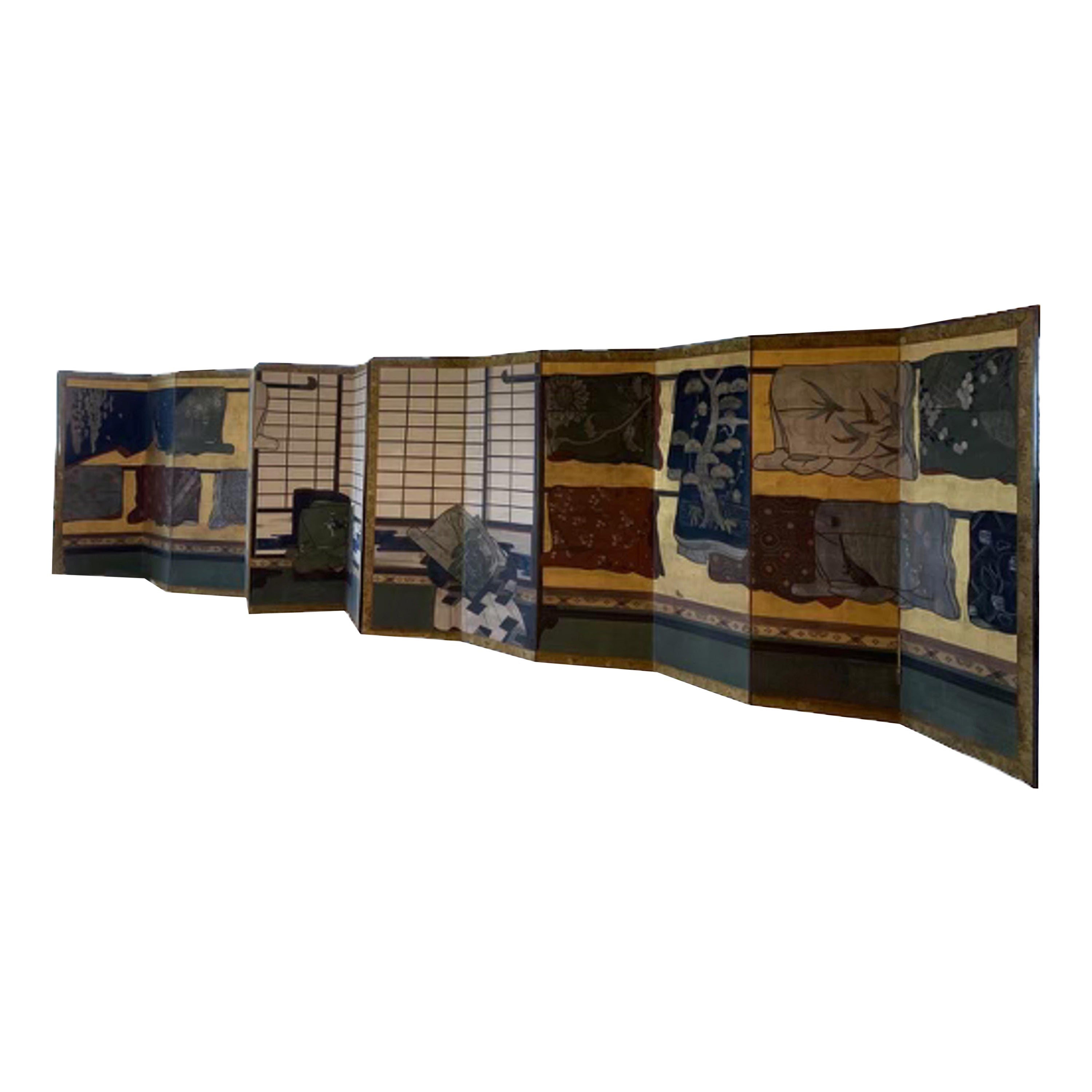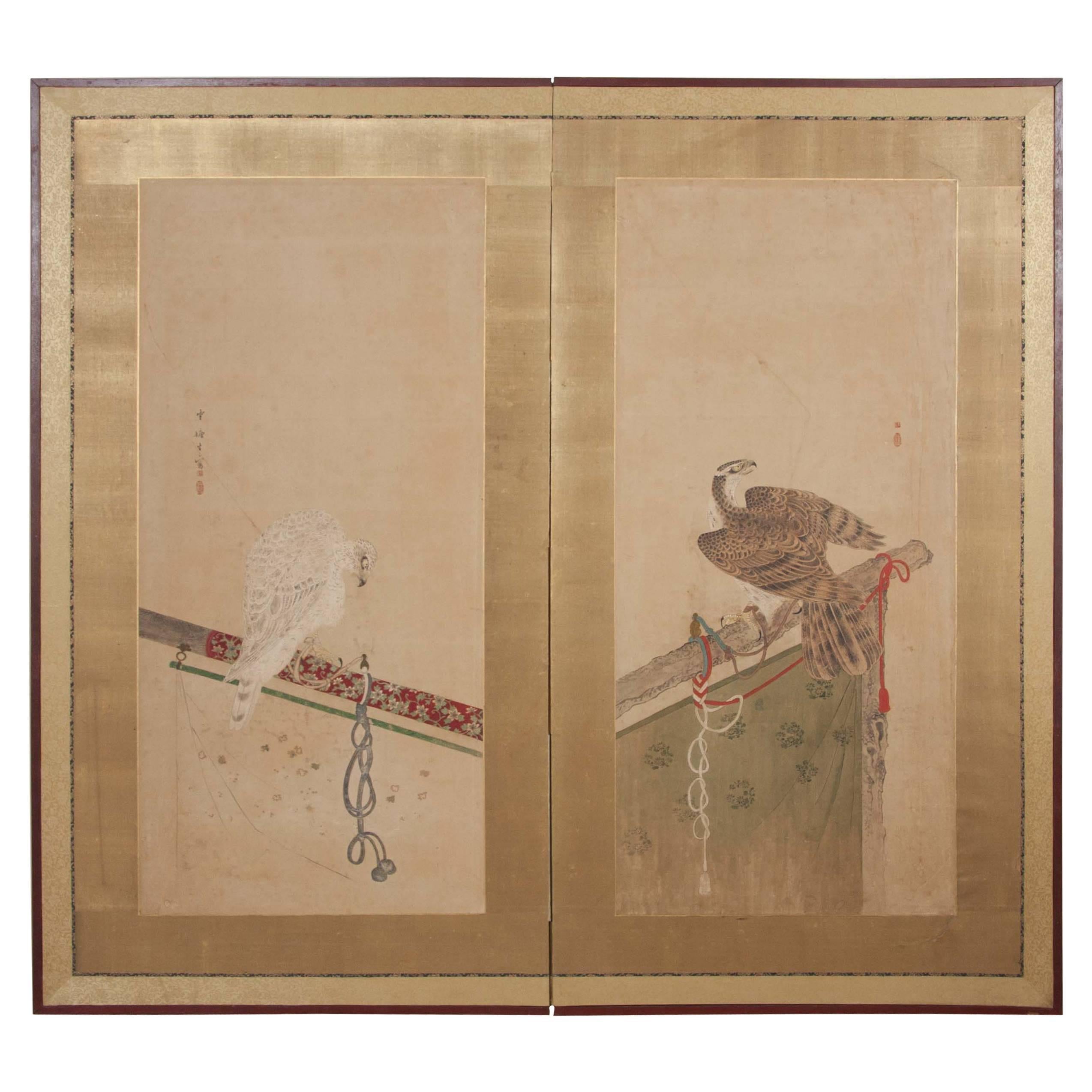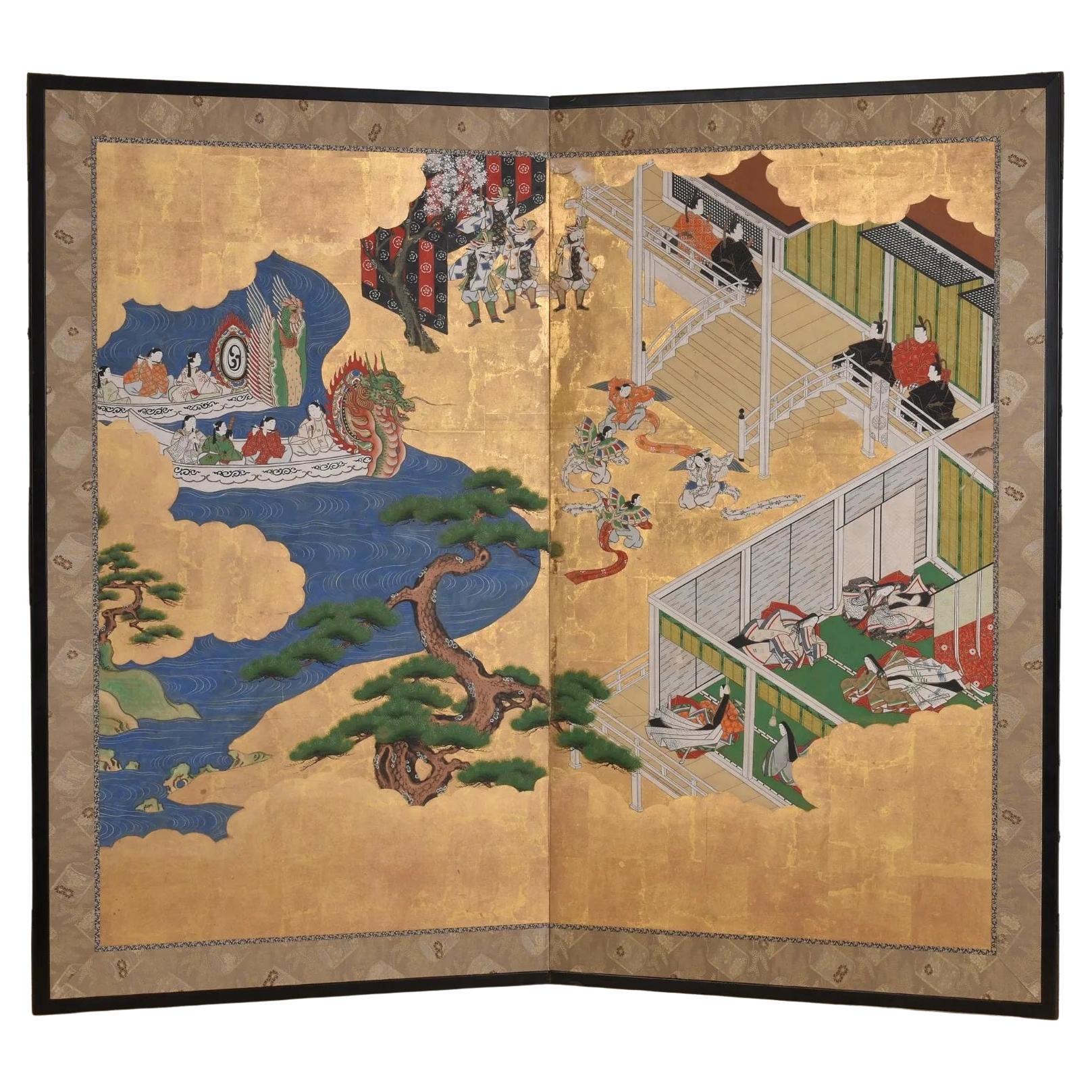Items Similar to 19th C. Edo-Meiji Period Japanese Painted Five-Panel Folding Miniature Screen
Want more images or videos?
Request additional images or videos from the seller
1 of 10
19th C. Edo-Meiji Period Japanese Painted Five-Panel Folding Miniature Screen
About the Item
19th century/Edo-Meiji period japanese painted five-panel folding miniature screen
By: unknown
Material: lacquer, metal, paint, wood
Technique: carved, hand-carved, hand-painted, lacquered, painted, varnished, metalwork
Dimensions: 1 in x 4.5 in x 8.5 in
Date: 19th century
Style: Edo, Meiji
Place of origin: Japan
This 5-panel Japanese folding screen features a larger central panel flanked by four smaller side panels attached with metal hinges. The dark, lacquered wood frames house white opaline sheets hand-painted with artwork in the style of the Edo to Meiji transitional period, including natural landscapes and architecture motifs. The reverse sides are unadorned.
The intricate hand-painted artwork framed in the lacquered wood panels gives this antique folding screen a refined and dignified aesthetic, making it an ideal tabletop decoration and graceful accent piece for an office or living room.
When fully extended, the screen measures 13.5 inches long.
- Dimensions:Height: 8.5 in (21.59 cm)Width: 4.5 in (11.43 cm)Depth: 1 in (2.54 cm)
- Style:Meiji (Of the Period)
- Materials and Techniques:
- Place of Origin:
- Period:
- Date of Manufacture:19th Century
- Condition:Wear consistent with age and use.
- Seller Location:North Miami, FL
- Reference Number:1stDibs: LU8678236214582
About the Seller
5.0
Platinum Seller
These expertly vetted sellers are 1stDibs' most experienced sellers and are rated highest by our customers.
Established in 2011
1stDibs seller since 2023
21 sales on 1stDibs
Typical response time: <1 hour
- ShippingRetrieving quote...Ships From: Buenos Aires, Argentina
- Return PolicyA return for this item may be initiated within 10 days of delivery.
More From This SellerView All
- Late 18th Century/Edo-Meiji Period Japanese Glazed Porcelain Sculpture of a DogLocated in North Miami, FLLate 18th century/Edo-Meiji period japanese glazed porcelain sculpture of a dog By: unknown Material: porcelain Technique: molded, pressed, glazed Dimensions: 5.5 in x 7.5 in x 5 Da...Category
Antique Late 18th Century Japanese Edo Sculptures and Carvings
MaterialsPorcelain
- Japanese Edo-Meiji Period Satsuma Incense Burner (Koro) and Wooden Support TableLocated in North Miami, FLJapanese 19th century Edo-Meiji Period Satsuma stoneware incense burner (Koro) with small wooden support table By: unknown Material: ceramic, stoneware, wood, enamel, paint Techniqu...Category
Antique 19th Century Japanese Edo Antiquities
MaterialsEnamel
- Late 19th Century Napoleon III Painted Porcelain Pedestal Circular Table, FranceLocated in North Miami, FLLate 19th century Napoleon III painted porcelain circular pedestal table with floral motifs made in France By: unknown Material: bronze, copper, ceramic, porcelain, paint, enamel, m...Category
Antique Late 19th Century French Napoleon III Pedestals
MaterialsMetal, Bronze, Copper, Enamel
- 20th Century/Shōwa Period Murashido Patinated and Polished Bronze Japanese VaseLocated in North Miami, FL20th century/Shōwa period murashido patinated and polished bronze japanese vase By: unknown Material: bronze, copper, metal Technique: murashido, cast, patinated, polished, metalwor...Category
20th Century Japanese Showa Metalwork
MaterialsBronze, Metal, Copper
- 19th Century/Qing Dinasty Glazed Hand-Painted Porcelain Man and Dog FigurineLocated in North Miami, FL19th Century/Qing Dinasty hand-painted glazed porcelain sitting man with scarf and dog figurine By: unknown Material: ceramic, porcelain, paint Technique: pressed, molded, painted, hand-painted, hadn-crafted, glazed Dimensions: 7 in x 8 in x 10 in Date: 19th century Style: Qing Place of origin: China This 19th century chinese porcelain figurine depicts a tender moment between man and his pet dog. An gentleman sits cradling a pup, their forms brought to life in hand-crafted detail. The man's intricately embroidered silk robe...Category
Antique 19th Century Chinese Qing Ceramics
MaterialsCeramic, Porcelain, Paint
- Mid-19th Century Neoclassical Gilt Footed Glass Goblet/Cup with Hand-Made PaintLocated in North Miami, FLMid-19th century neoclassical gilt footed glass goblet/cup with hand-made paint By: unknown Material: glass, paint, cut glass Technique: cast, hand-painted, cast, painted Dimensions: 5 in x 8.5 in Date: mid-19th century, circa 1840 Style: Neoclassical, Revival Place of origin: Austria (probably) This mid-19th century goblet...Category
Antique Mid-19th Century Austrian Neoclassical Revival Glass
MaterialsGlass, Paint, Cut Glass
You May Also Like
- 19th Century Shibayama Four Panel Screen Meiji Period Japan, C.1880Located in London, GB19th century Shibayama four Panel screen Meiji Period Japan C.1880 Mother of pearl inlay in black lacquer depicting a bird in relief with cherry blossom. The lower section with gi...Category
Antique 19th Century Japanese Meiji Paintings and Screens
MaterialsMother-of-Pearl, Wood, Lacquer
- Edo Period 19th Century Japanese Folding Screen Six Panels Flowers on Gold LeafBy Rimpa SchoolLocated in Brescia, ITClouds of gold, water and many colorful flowers: Japanese six-panel folding screen by Rimpa School. Hand painted with rice mineral pigments and inks on rice paper and gold leaf.Category
Antique Early 19th Century Japanese Edo Paintings and Screens
MaterialsGold Leaf
- 17th Century 'Late 1600s', Japanese Edo Period 12-Panel Folding Screen PaintedLocated in North Miami, FLA pair of 17th Century (Late 1600s) Japanese Edo screens made of 12-panels. This folding silk screen is painted on a gold leaf background. It has a...Category
Antique 17th Century Japanese Edo Paintings and Screens
MaterialsSilk, Wood, Paint, Paper
- Japanese Edo Period Two-Panel ScreenLocated in Stamford, CTA Japanese Edo Period two panel folding screen with white and brown hawks of ink and color on paper.Category
Antique Mid-19th Century Japanese Edo Paintings and Screens
MaterialsPaper
- Japanese Six Panel Screen with Hotei, Edo Period, Early 19th CenturyLocated in Austin, TXA delightful Japanese six panel painted paper screen featuring the beloved figure Hotei, Edo Period, early 19th century. Hotei, called Budai in China, and known as the Laughing Buddha or Fat Buddha in the West, is considered to be an emanation of Maitreya, the Buddha of the Future. In Japan, he also holds a special place as one of the Seven Lucky Gods, being the god of fortune, and protector of children. He is always portrayed as a mirthful and corpulent man, dressed in loose robes that show off his round belly. He carries a sack with him, said to be filled with treasure. As the protector of children, he is often portrayed with them playing on or around him, as he is here. The children portrayed in this screen are dressed in Chinese style clothing...Category
Antique Early 19th Century Japanese Edo Paintings and Screens
MaterialsSilk, Paper
- Japanese Meiji Period Two Panel ScreenLocated in Stamford, CTJapanese Meiji Period (1868-1912) two-panel painted screen with various Tale of Genji scenes - ink, colors and gold leaf on paper.Category
Antique 1870s Japanese Paintings and Screens
MaterialsPaper
Recently Viewed
View AllMore Ways To Browse
Japanese Panel Lacquered
Antique Japanese Carved Screen
Hand Painted Asian Screen
Japanese Silk Landscape
Chinese Screen With Mother Of Pearl
Qing Dynasty Room Divider
Metal Decorative Screens For Air Conditioner
Key Kaaba
6 Fold Meiji
Shibata Zeshin
12 Panel Coromandel Screen
6 Panel Screen With Cranes
Gracie Silk
Japanese Leopard Screen
Kano Naonobu
Koi Fish Silk Painted Screens
Vintage Silk Painting Geisha
Battle Of Yashima





